The First Museum of Family Correspondence Established at RUC
2016.10.28
On the morning of the 26th of October, the Museum of Family Correspondence, the first of its kind in China, was founded and formally opened at RUC. The official sign for the museum was inscribed by renowned calligrapher Mr CHEN Peng, and the museum plaque was unveiled by Vice Chairman of the 10th session of the CPPCC ZHANG Huaixi and senior member of the University Council ZHANG Jianming.
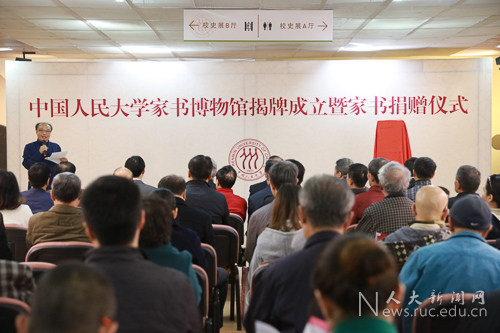 The unveiling ceremony was attended by many representatives of government and museums from around the nation, including many of the benefactors who contributed to the museum’s exhibits.
In a speech given by Vice President HE Yaomin on behalf of the university, he said that in the past years RUC museum’s exhibition of family correspondence had moved ahead in leaps and bounds. In order to propel the development of the project, approval for the Museum of Family Correspondence was approved by the RUC, and has been given official status by the Beijing Municipal Bureau of Cultural Relics. The Museum of Family Correspondence is a university museum specialising in letters and correspondence, being part of the Family Correspondence Cultural Research Centre with a collection of over 50,000 letters in storage. The Family Correspondence Museum is currently operating a restoration project, with its chief responsibilities being the storage, protection, research, exhibition, and promotion of traditional specimens of correspondence. It is working hard towards building a national base for the collection of national correspondence so as to showcase what these specimens tells us about our customs and cultural traditions of a past eras. The establishment of RUC’s Museum of Family Correspondence is a turning point, marking a significant contribution to the collection, exhibition, and research of this important aspect of Chinese traditional culture.
The unveiling ceremony was attended by many representatives of government and museums from around the nation, including many of the benefactors who contributed to the museum’s exhibits.
In a speech given by Vice President HE Yaomin on behalf of the university, he said that in the past years RUC museum’s exhibition of family correspondence had moved ahead in leaps and bounds. In order to propel the development of the project, approval for the Museum of Family Correspondence was approved by the RUC, and has been given official status by the Beijing Municipal Bureau of Cultural Relics. The Museum of Family Correspondence is a university museum specialising in letters and correspondence, being part of the Family Correspondence Cultural Research Centre with a collection of over 50,000 letters in storage. The Family Correspondence Museum is currently operating a restoration project, with its chief responsibilities being the storage, protection, research, exhibition, and promotion of traditional specimens of correspondence. It is working hard towards building a national base for the collection of national correspondence so as to showcase what these specimens tells us about our customs and cultural traditions of a past eras. The establishment of RUC’s Museum of Family Correspondence is a turning point, marking a significant contribution to the collection, exhibition, and research of this important aspect of Chinese traditional culture.
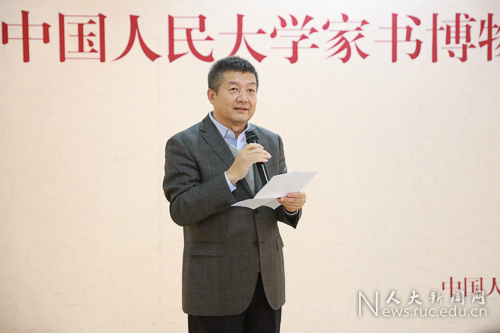 Director ZHENG Shuiquan makes an oration at the museum’s opening.
Director ZHENG Shuiquan makes an oration at the museum’s opening.
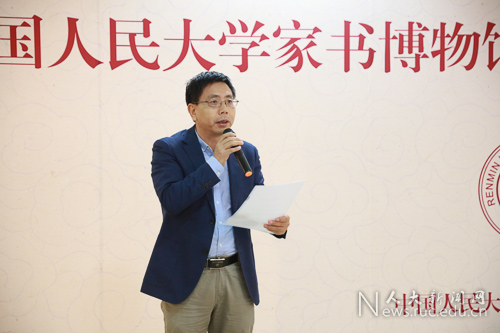 Director HA Jun reads out the letter of approval from the Beijing Municipal Bureau of Cultural Relics.
Director HA Jun reads out the letter of approval from the Beijing Municipal Bureau of Cultural Relics.
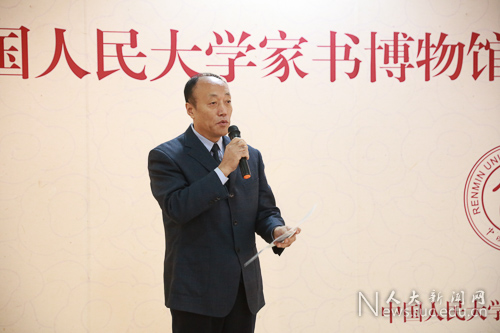 Vice Chairman ZHANG Huaixi and Councillor ZHANG Jianming unveil the museum plaque.
Vice Chairman ZHANG Huaixi and Councillor ZHANG Jianming unveil the museum plaque.
 Shortly after the unveiling, the donation ceremony was held. Beijing collector FANG Xuxiao, RUC School of Journalism Professor CHEN Lidan, Jiangxi collector ZHANG Shulin, Anhui collector ZHU Yingshou, Jilin letter restoration specialist MA Youlian and others together donated over 1000 letters to the collection, including 4 bundles of correspondence from the late Qing and Republic of China era, 29 diaries and 15 collections of calligraphy. Councillor ZHANG Jianming and Vice President HE Yaomin awarded the donors with certificates as an expression of gratitude.
Shortly after the unveiling, the donation ceremony was held. Beijing collector FANG Xuxiao, RUC School of Journalism Professor CHEN Lidan, Jiangxi collector ZHANG Shulin, Anhui collector ZHU Yingshou, Jilin letter restoration specialist MA Youlian and others together donated over 1000 letters to the collection, including 4 bundles of correspondence from the late Qing and Republic of China era, 29 diaries and 15 collections of calligraphy. Councillor ZHANG Jianming and Vice President HE Yaomin awarded the donors with certificates as an expression of gratitude.
 Mr FANG’s donation includes a letter written by former RUC Council Chairman and Vice President GUO Yingqiu on the 7th of July 1966, a 41-page open letter written during the Cultural Revolution to the staff and students of RUC; a letter written by former Director of the RUC library ZHANG Zhao on the 31st of May 1967, and letters from many other former leaders of the University. One contribution of particular note, and significant value, is also by GUO Yingqiu, containing letters and manuscripts discussing education during the Cultural Revolution era.
Professor CHEN Lidan donated a collection of his father CHEN Chao’s letters from between 1956 and 2015; in total 29 items including diaries and manuscripts, as well as little messages that he had left on postal remittance notes. These diaries not only provide an invaluable primary source detailing his day-to-day family life, but also precious insight into his personal views on the vicissitudes of life. Born in 1929, CHEN Chao held the honour of being the creator of the “First Map of the New China.” When he was 16 he started working as a cartographer, working for many of China’s top cartography businesses. After 1955, he worked for China Cartography Press where he rapidly climbed the ranks, from editor, to director, to editor-in-chief. He worked for a total of 70 years in the industry, with his diligence and meticulousness a great contribution to China’s cartography industry. In 2004 he published a book called Sixty Years of Cartography.
Mr ZHANG Shulin donation consists of letters from between the 1980s to the year 2000. These letters are largely from workers and soldiers from Jiangxi province, Qianshan county to their families, in total 413 letters. Mr ZHU Yingshou donated letters written between 1960 to 1990 from Anhui province Huangshan region including letters to family from students and soldiers; in total his donation consists of over 515 letters and 4 volumes of correspondence dating back to the late Qing and Republic of China eras.
After the donation ceremony, Curator of the National Bureau of Cultural Relics Museum DUAN Yong and others gave a speech expressing their congratulations at the establishment of the new museum, and thanking all donors for their generous contributions to the museum. They also emphasised the importance of this collection in preserving China’s cultural heritage, expressing their hope that this new museum will make a great contribution to China’s cultural legacy.
Mr FANG’s donation includes a letter written by former RUC Council Chairman and Vice President GUO Yingqiu on the 7th of July 1966, a 41-page open letter written during the Cultural Revolution to the staff and students of RUC; a letter written by former Director of the RUC library ZHANG Zhao on the 31st of May 1967, and letters from many other former leaders of the University. One contribution of particular note, and significant value, is also by GUO Yingqiu, containing letters and manuscripts discussing education during the Cultural Revolution era.
Professor CHEN Lidan donated a collection of his father CHEN Chao’s letters from between 1956 and 2015; in total 29 items including diaries and manuscripts, as well as little messages that he had left on postal remittance notes. These diaries not only provide an invaluable primary source detailing his day-to-day family life, but also precious insight into his personal views on the vicissitudes of life. Born in 1929, CHEN Chao held the honour of being the creator of the “First Map of the New China.” When he was 16 he started working as a cartographer, working for many of China’s top cartography businesses. After 1955, he worked for China Cartography Press where he rapidly climbed the ranks, from editor, to director, to editor-in-chief. He worked for a total of 70 years in the industry, with his diligence and meticulousness a great contribution to China’s cartography industry. In 2004 he published a book called Sixty Years of Cartography.
Mr ZHANG Shulin donation consists of letters from between the 1980s to the year 2000. These letters are largely from workers and soldiers from Jiangxi province, Qianshan county to their families, in total 413 letters. Mr ZHU Yingshou donated letters written between 1960 to 1990 from Anhui province Huangshan region including letters to family from students and soldiers; in total his donation consists of over 515 letters and 4 volumes of correspondence dating back to the late Qing and Republic of China eras.
After the donation ceremony, Curator of the National Bureau of Cultural Relics Museum DUAN Yong and others gave a speech expressing their congratulations at the establishment of the new museum, and thanking all donors for their generous contributions to the museum. They also emphasised the importance of this collection in preserving China’s cultural heritage, expressing their hope that this new museum will make a great contribution to China’s cultural legacy.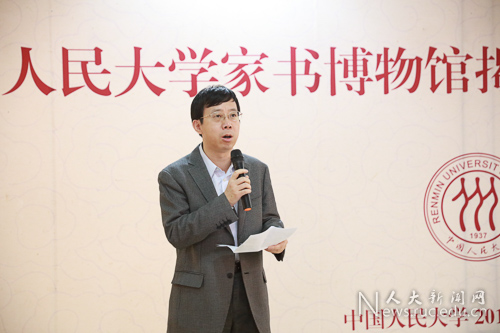 (Curator of National Bureau of Cultural Relics Museum DUAN Yong delivers his speech)
(Curator of National Bureau of Cultural Relics Museum DUAN Yong delivers his speech)
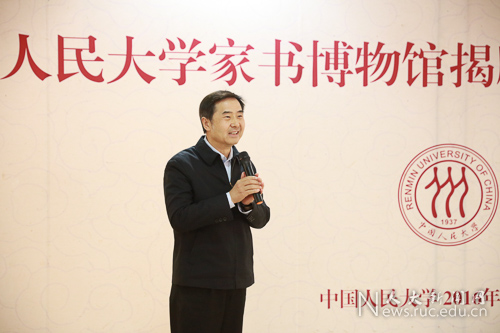 (Vice Chairman of the Association of Chinese Folk Art LUO Yang delivers his speech)
(Vice Chairman of the Association of Chinese Folk Art LUO Yang delivers his speech)
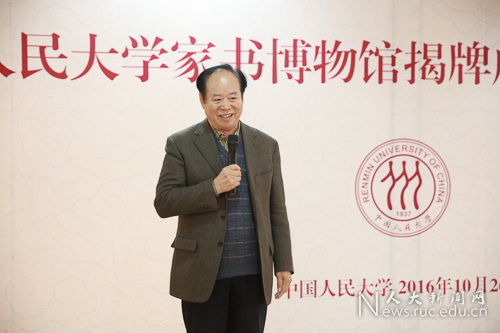 (Deputy Director of the National Museum MA Yingmin delivers his speech)
(Deputy Director of the National Museum MA Yingmin delivers his speech)
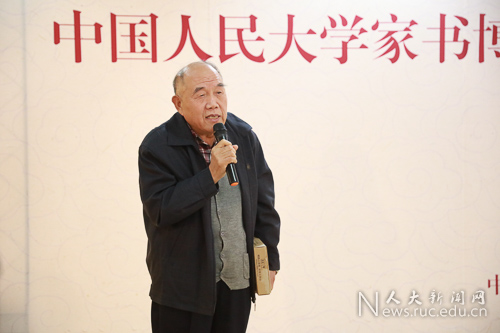 (Former Council Chairman of the Tianjin Municipal Postal Service and Deputy Director CHOU Runxi delivers his speech)
Following the unveiling ceremony, Vice Chairman ZHANG Huaixi takes a tour of the exhibition accompanied by Vice President HE Yaomin, and was outspoken in his praise for the content of the collection.
(Former Council Chairman of the Tianjin Municipal Postal Service and Deputy Director CHOU Runxi delivers his speech)
Following the unveiling ceremony, Vice Chairman ZHANG Huaixi takes a tour of the exhibition accompanied by Vice President HE Yaomin, and was outspoken in his praise for the content of the collection.
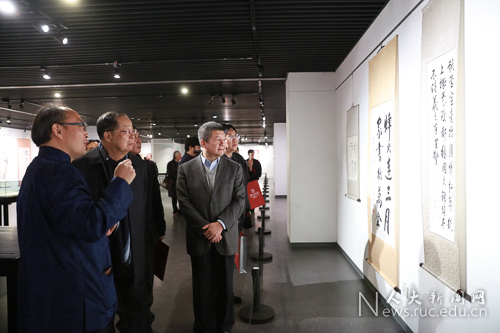
 The Museum of Family Correspondence is situated in the 3rd level of Renmin University’s museum, with the exhibition of family correspondence, dairies and memoirs being held year-round. This permanent exhibition is called “The allure of a letter – an exhibition of China’s traditional family correspondence,” and is free for the general public to visit on Mondays, Wednesdays and Fridays.
The Museum of Family Correspondence is situated in the 3rd level of Renmin University’s museum, with the exhibition of family correspondence, dairies and memoirs being held year-round. This permanent exhibition is called “The allure of a letter – an exhibition of China’s traditional family correspondence,” and is free for the general public to visit on Mondays, Wednesdays and Fridays.
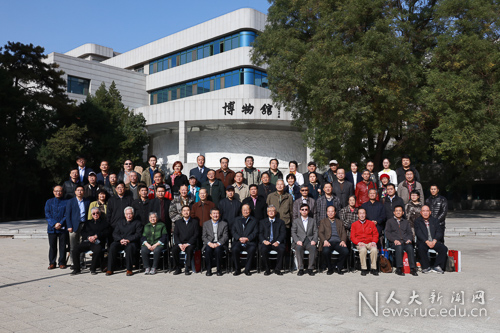
 The unveiling ceremony was attended by many representatives of government and museums from around the nation, including many of the benefactors who contributed to the museum’s exhibits.
In a speech given by Vice President HE Yaomin on behalf of the university, he said that in the past years RUC museum’s exhibition of family correspondence had moved ahead in leaps and bounds. In order to propel the development of the project, approval for the Museum of Family Correspondence was approved by the RUC, and has been given official status by the Beijing Municipal Bureau of Cultural Relics. The Museum of Family Correspondence is a university museum specialising in letters and correspondence, being part of the Family Correspondence Cultural Research Centre with a collection of over 50,000 letters in storage. The Family Correspondence Museum is currently operating a restoration project, with its chief responsibilities being the storage, protection, research, exhibition, and promotion of traditional specimens of correspondence. It is working hard towards building a national base for the collection of national correspondence so as to showcase what these specimens tells us about our customs and cultural traditions of a past eras. The establishment of RUC’s Museum of Family Correspondence is a turning point, marking a significant contribution to the collection, exhibition, and research of this important aspect of Chinese traditional culture.
The unveiling ceremony was attended by many representatives of government and museums from around the nation, including many of the benefactors who contributed to the museum’s exhibits.
In a speech given by Vice President HE Yaomin on behalf of the university, he said that in the past years RUC museum’s exhibition of family correspondence had moved ahead in leaps and bounds. In order to propel the development of the project, approval for the Museum of Family Correspondence was approved by the RUC, and has been given official status by the Beijing Municipal Bureau of Cultural Relics. The Museum of Family Correspondence is a university museum specialising in letters and correspondence, being part of the Family Correspondence Cultural Research Centre with a collection of over 50,000 letters in storage. The Family Correspondence Museum is currently operating a restoration project, with its chief responsibilities being the storage, protection, research, exhibition, and promotion of traditional specimens of correspondence. It is working hard towards building a national base for the collection of national correspondence so as to showcase what these specimens tells us about our customs and cultural traditions of a past eras. The establishment of RUC’s Museum of Family Correspondence is a turning point, marking a significant contribution to the collection, exhibition, and research of this important aspect of Chinese traditional culture.
 Director ZHENG Shuiquan makes an oration at the museum’s opening.
Director ZHENG Shuiquan makes an oration at the museum’s opening.
 Director HA Jun reads out the letter of approval from the Beijing Municipal Bureau of Cultural Relics.
Director HA Jun reads out the letter of approval from the Beijing Municipal Bureau of Cultural Relics.
 Vice Chairman ZHANG Huaixi and Councillor ZHANG Jianming unveil the museum plaque.
Vice Chairman ZHANG Huaixi and Councillor ZHANG Jianming unveil the museum plaque.
 Shortly after the unveiling, the donation ceremony was held. Beijing collector FANG Xuxiao, RUC School of Journalism Professor CHEN Lidan, Jiangxi collector ZHANG Shulin, Anhui collector ZHU Yingshou, Jilin letter restoration specialist MA Youlian and others together donated over 1000 letters to the collection, including 4 bundles of correspondence from the late Qing and Republic of China era, 29 diaries and 15 collections of calligraphy. Councillor ZHANG Jianming and Vice President HE Yaomin awarded the donors with certificates as an expression of gratitude.
Shortly after the unveiling, the donation ceremony was held. Beijing collector FANG Xuxiao, RUC School of Journalism Professor CHEN Lidan, Jiangxi collector ZHANG Shulin, Anhui collector ZHU Yingshou, Jilin letter restoration specialist MA Youlian and others together donated over 1000 letters to the collection, including 4 bundles of correspondence from the late Qing and Republic of China era, 29 diaries and 15 collections of calligraphy. Councillor ZHANG Jianming and Vice President HE Yaomin awarded the donors with certificates as an expression of gratitude.
 Mr FANG’s donation includes a letter written by former RUC Council Chairman and Vice President GUO Yingqiu on the 7th of July 1966, a 41-page open letter written during the Cultural Revolution to the staff and students of RUC; a letter written by former Director of the RUC library ZHANG Zhao on the 31st of May 1967, and letters from many other former leaders of the University. One contribution of particular note, and significant value, is also by GUO Yingqiu, containing letters and manuscripts discussing education during the Cultural Revolution era.
Professor CHEN Lidan donated a collection of his father CHEN Chao’s letters from between 1956 and 2015; in total 29 items including diaries and manuscripts, as well as little messages that he had left on postal remittance notes. These diaries not only provide an invaluable primary source detailing his day-to-day family life, but also precious insight into his personal views on the vicissitudes of life. Born in 1929, CHEN Chao held the honour of being the creator of the “First Map of the New China.” When he was 16 he started working as a cartographer, working for many of China’s top cartography businesses. After 1955, he worked for China Cartography Press where he rapidly climbed the ranks, from editor, to director, to editor-in-chief. He worked for a total of 70 years in the industry, with his diligence and meticulousness a great contribution to China’s cartography industry. In 2004 he published a book called Sixty Years of Cartography.
Mr ZHANG Shulin donation consists of letters from between the 1980s to the year 2000. These letters are largely from workers and soldiers from Jiangxi province, Qianshan county to their families, in total 413 letters. Mr ZHU Yingshou donated letters written between 1960 to 1990 from Anhui province Huangshan region including letters to family from students and soldiers; in total his donation consists of over 515 letters and 4 volumes of correspondence dating back to the late Qing and Republic of China eras.
After the donation ceremony, Curator of the National Bureau of Cultural Relics Museum DUAN Yong and others gave a speech expressing their congratulations at the establishment of the new museum, and thanking all donors for their generous contributions to the museum. They also emphasised the importance of this collection in preserving China’s cultural heritage, expressing their hope that this new museum will make a great contribution to China’s cultural legacy.
Mr FANG’s donation includes a letter written by former RUC Council Chairman and Vice President GUO Yingqiu on the 7th of July 1966, a 41-page open letter written during the Cultural Revolution to the staff and students of RUC; a letter written by former Director of the RUC library ZHANG Zhao on the 31st of May 1967, and letters from many other former leaders of the University. One contribution of particular note, and significant value, is also by GUO Yingqiu, containing letters and manuscripts discussing education during the Cultural Revolution era.
Professor CHEN Lidan donated a collection of his father CHEN Chao’s letters from between 1956 and 2015; in total 29 items including diaries and manuscripts, as well as little messages that he had left on postal remittance notes. These diaries not only provide an invaluable primary source detailing his day-to-day family life, but also precious insight into his personal views on the vicissitudes of life. Born in 1929, CHEN Chao held the honour of being the creator of the “First Map of the New China.” When he was 16 he started working as a cartographer, working for many of China’s top cartography businesses. After 1955, he worked for China Cartography Press where he rapidly climbed the ranks, from editor, to director, to editor-in-chief. He worked for a total of 70 years in the industry, with his diligence and meticulousness a great contribution to China’s cartography industry. In 2004 he published a book called Sixty Years of Cartography.
Mr ZHANG Shulin donation consists of letters from between the 1980s to the year 2000. These letters are largely from workers and soldiers from Jiangxi province, Qianshan county to their families, in total 413 letters. Mr ZHU Yingshou donated letters written between 1960 to 1990 from Anhui province Huangshan region including letters to family from students and soldiers; in total his donation consists of over 515 letters and 4 volumes of correspondence dating back to the late Qing and Republic of China eras.
After the donation ceremony, Curator of the National Bureau of Cultural Relics Museum DUAN Yong and others gave a speech expressing their congratulations at the establishment of the new museum, and thanking all donors for their generous contributions to the museum. They also emphasised the importance of this collection in preserving China’s cultural heritage, expressing their hope that this new museum will make a great contribution to China’s cultural legacy. (Curator of National Bureau of Cultural Relics Museum DUAN Yong delivers his speech)
(Curator of National Bureau of Cultural Relics Museum DUAN Yong delivers his speech)
 (Vice Chairman of the Association of Chinese Folk Art LUO Yang delivers his speech)
(Vice Chairman of the Association of Chinese Folk Art LUO Yang delivers his speech)
 (Deputy Director of the National Museum MA Yingmin delivers his speech)
(Deputy Director of the National Museum MA Yingmin delivers his speech)
 (Former Council Chairman of the Tianjin Municipal Postal Service and Deputy Director CHOU Runxi delivers his speech)
Following the unveiling ceremony, Vice Chairman ZHANG Huaixi takes a tour of the exhibition accompanied by Vice President HE Yaomin, and was outspoken in his praise for the content of the collection.
(Former Council Chairman of the Tianjin Municipal Postal Service and Deputy Director CHOU Runxi delivers his speech)
Following the unveiling ceremony, Vice Chairman ZHANG Huaixi takes a tour of the exhibition accompanied by Vice President HE Yaomin, and was outspoken in his praise for the content of the collection.

 The Museum of Family Correspondence is situated in the 3rd level of Renmin University’s museum, with the exhibition of family correspondence, dairies and memoirs being held year-round. This permanent exhibition is called “The allure of a letter – an exhibition of China’s traditional family correspondence,” and is free for the general public to visit on Mondays, Wednesdays and Fridays.
The Museum of Family Correspondence is situated in the 3rd level of Renmin University’s museum, with the exhibition of family correspondence, dairies and memoirs being held year-round. This permanent exhibition is called “The allure of a letter – an exhibition of China’s traditional family correspondence,” and is free for the general public to visit on Mondays, Wednesdays and Fridays.



